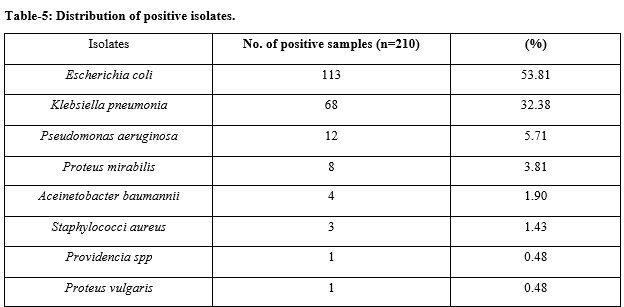A study on prevalence of bacterial isolates causing urinary tract infection at tertiary care hospital, Rajkot, Gujarat, India
Abstract
Introduction: Urinary tract infection is most common bacterial infectious disease after respiratory tract infection disease in community practice. The introduction of antimicrobial therapy has contributed significantly to the management of UTIs.
Objective: This study was conducted to identify bacterial isolates causing urinary tract infection & their prevalence in different age and gender. Material & Methods: 1000 Urine Samples received at Tertiary Care Hospital, Rajkot during year 2017 were tested for bacterial pathogen by Culture and Bio-chemical reaction.
Results: Out of 1000 samples, 210 (21%) samples were found positive for UTI Isolates. Out of 210 positive cases, the prevalence of UTI was higher in female patients (56.19%) than in male patients (43.81%). The highest susceptible age group of patients to UTI was found in 21-40 years (33.33%). The highest prevalence of UTI in female patient was found in the age group of 21-40 years (44.92%) while in male patients the highest susceptible age group to UTI was above 60 years (35.87%). E. coli was the most common isolate (53.81%).
Conclusion: Present study reported that E. coli isolate was the predominant pathogens causing UTI which mainly affected female. The study also allows comparison of the situation in Rajkot with other regions within and outside the state as well as in the country or outside the country. The knowledge of local prevalence of causative uropathogens and their respective antimicrobial sensitivity will help to reduce the incidence of resistance, empirical antibiotic selection in treatment of UTI.
Downloads
References
2. Vasquez Y, Hand WL. Antibiotic susceptibility patterns of community acquired urinary tract infection isolates from female patients on the US (Texas)-Mexico Border. J Appl. Res. 2004; 4(2):321-6.
3. Schaeffer AJ, Rajan N, Cao Q, Host pathogenesis in urinary tract infections. International Journal of Antimicrobial Agents.2001;17(4):245-251.DOI: https:// doi. org/10. 1016/S0924-8579(01)00302-8
4. Arul KC, Prakasam KG, Kumar D, and Vijayan M. A cross-sectional study on distribution of urinary tract infection and their antibiotic utilization pattern in Kerala. Int J Res Phamaceut Biomed Sci. 2012;3(3): 1125-1130.
5. Gonzalez CM and Schaeffer AJ. Treatment of urinary tract infection: what’s old, what’s new and what works. World J Urol.1999; 17(6):372-382.
6. Omoregie R, Erebor JO, Ahonkhai I, Isobor JO, Ogefere HO. Observed changes in the prevalence of uropathogens in Benin City, Nigeria. NZJ Med Lab Sci. 2008; 62:29-31.
7. Omoregie R, Eghafona NO. Urinary tract infection among asymptomatic HIV patients in Benin City, N gria. Br J Biomed Sci. 2009;66:190–3.DOI: https://doi. org/10.1080/09674845.2009.11730272
8. Tambekar DH, Dhanorkar DV, Gulhane SR, Khandelwal VK, Dudhane MN. Antimicrobial suscepti-bility of some urinary tract pathogens to commonly used antibiotics. Biotechnol. 2006;5 (17): 1562-5.
9. Bonadio M, Meini M, Spetaleri P, Gilgi C.Current microbiological and clinical aspects of urinary tract infections. Eur J Urol. 2001;40(4):439-45.
10. Grude N, Tveten Y, Kristiansen BE. Urinary tract infections in Norway: bacterial etiology and susceptibility, a retrospective study of clinical isolates. Clin Microbial Infect. 2001;7(10):543-7. DOI: https:// doi.org/10.1111/j.1469-0691.2001.00306.x
11. McNulty CA, Richards J, Livermore DM, Little P, Charlett A, Freeman E et al. Clinical relevance of laboratory-reported antibiotic resistance in acute uncomplicated urinary tract infection in primary care. J Antimicrob Chemotherap. 2006;58(5);1000-1008. DOI: https://doi.org/10.1093/jac/dkl368
12. Akram M, Shahid M, Khan AU. Annals of Clinical Microbiology and Antimicrobials, Etiology and antibiotic resistance patterns of community acquired urinary tract infections in JN MC hospital Aligarth, India. Ann Clin Microbiol Antimicrob. 2007;6(4):1-7.
13. Sood S, Gupta R. Antibiotic Resistance Pattern of Community Acquired Uropathogens at a Tertiary Care Hospital in Jaipur, Rajasthan. Indian J Commun Med. 2012;37(1):39-44. DOI: 10.4103/0970-0218.94023
14. Nerulkar A, Solanky P, Naik SS. Bacterial pathogens in urinary tract infection and antibiotic susceptibility pattern. J Pharmaceut Biomed Sci. 2012; 21(12):1-3
15. Parveen R, Md. Yushuf A, Sharmin I, Md Islam S, Rahim I. Antibiotic Sensitivity of Bacteria Causing Urinary Tract Infection Bang J Infect Dis. 2015;2 (1): 13-18. DOI: https://doi.org/10.3329/ bjid.v2i1.31324
16. Nazreen Khan, Mohd. Shahid khan. Prevalence of Antimicrobial Resistance in Bacterial Isolates causing Urinary Tract Infection in Patients attending IIMS & R Hospital, Lucknow. Int J Life Sci & Scientific Res. 2016; 2(1):1-8.
17. Kothari A, Sagar V. Antibiotic resistance in pathogens causing community acquired urinary tract infection in India: a multicentre study. J. infect Developing Countries. 2008;2(5):354-358.
18. Shalini, Joshi MC, Rashid MK, Joshi HK. Study of Antibiotic Sensitivity Pattern in Urinary Tract Infection at a Tertiary Hospital. Nat J Integ Res Med. 2011;2(3): 43-46.
19. Prakash D, Saxena RS. Distribution and antimicrobial susceptibility pattern of bacterial pathogens causing urinary tract infection in urban community of Meerut City, India. ISRN Microbiology; 2013. DOI: 10.1155/2013/749629
20. Shyamala R, Ravinder N, Shazia Parveen, Janardhan Rao, Escherichia coli as the commonest uropethogen in a tertiary care hospital. J Microbiol Biotechnol Res. 2013; 3(6): 49-51.
21. Setu SK, Sattar AN, Saleh AA, Roy CK, Ahmed M, Muhammadullah S, et al. Study of Bacterial pathogens in Urinary Tract Infection and their antibiotic resistance profile in a tertiary care hospital of Bangladesh. Bangladesh J Med Microbial. 2016; 10 (1): 22-26. DOI: https://doi.org/10.3329/bjmm.v10i1.31449



 OAI - Open Archives Initiative
OAI - Open Archives Initiative


